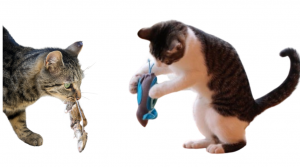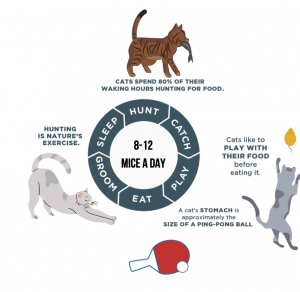By Dr. Liz Bales

Cats are hunters and seeking out food, catching it, and playing provides mental engagement and physical exercise © Dr. Liz Bales
What is the essence of a cat? When we understand what motivates a cat’s behavior, we understand what to expect from a cat — as a human companion and a companion to other cats in our homes. With this information, we can rethink the criteria for a minimally satisfactory physical living space in the confinement of our homes.
Well-being for all living things begins with basic survival. How do cats survive and stay safe? How do they eat, drink, and sustain themselves? What are the threats to a cat’s safety, and how are they innately programmed to protect themselves from these threats? How do cats communicate and interact with the world, and each other? This is basic survival for a cat.
Just about everything you need to know about cats comes down to one thing. Hunting.
Cats in the Wild
Cats are exquisite hunters. They need to be. One cat needs to hunt, catch, kill, and eat 8-12 mice every single day to stay alive. It takes about 80% of a cat’s waking hours to accomplish this. Nature gave cats a strong innate drive to hunt to ensure they stay alive, even if there is plentiful food (iCatCare, 2019).
A cat’s stomach is only the size of a ping-pong ball, just right for a mouse-sized meal, one at a time. Mice do not hang around in groups all day waiting to be eaten. They hide from cats, and scurry around alone, usually at dawn and dusk when the darkness can help protect them. So, cats are instinctively driven to hunt at dawn and dusk. They do not rely on their sight, like you and I do. Cats use their sense of smell, hearing, and perception of movement to locate their prey.

Cats use their sense of smell, hearing, and perception of movement to locate their prey © Dr. Liz Bales
Feeding Behavior
So much about a cat’s feeding behavior dictates the rest of their lives too. Mouse-sized meals are not enough to share, so cats hunt and eat alone. You don’t see a group of house cats working together to bring down a deer and dining on the carcass together. One cat hunts, kills, and eats one mouse at a time.
If a location has more cats than meals, cats starve. Eight to 12 mice every single day is a lot of mice, so cats are careful to protect their food sources. The result? Cats are extremely territorial. And if you are going to have to hunt and eat alone, you had better be able to depend on yourself to stay safe. And that is exactly how cats evolved.
Solitary Survivors
Cats are solitary survivors. They do not defend each other, protect each other, or count on each other to sustain life. If they are sick, hurt, or have a need, no other cat is coming to help them. This is not malicious, vengeful, or unkind, it is simply the way nature made them. Therefore, it is of no benefit to them to show that they are sick, hurt, or have a need. Showing this vulnerability will not bring assistance but is highly likely to tip off a predator that they are easy prey.
Groups of related mothers and kittens may live together, if there is enough food and safe shelter to meet all of their individual needs and the needs of the group. These mother cats grew up together, have lived together, and smell like each other. They are not receptive to new cats entering the group (iCatCare, 2018b).
If it comes down to a territorial fight between two cats, it is highly likely that one or both of the contenders will be injured or killed. In the wild, injury from fights often leads to death. So, nature designed cats to do everything they can to avoid conflict and even interacting with the competition. So, cats find ways to communicate with each other without being present.
Sense of Smell
To avoid unwanted interactions, cats leave lots of communication around their territory. Often one “sign,” like urine marking or leaving claw marks on a tree, communicates in many ways, including smell, pheromones, and visual cues.
Cats’ sense of smell is far superior to that of humans. The olfactory epithelium in cats is 20 cm2 where they have 200 million scent receptors. By comparison, humans have only 2-4 cm2 of olfactory epithelium and have only 5 million scent receptors (College of Agricultural, Environmental and Consumer Sciences, n.d.).
In addition to smell, cats have a sophisticated chemical messaging system using pheromones. Pheromones are odorless chemicals produced by specialized glands on a cat’s cheeks, under the chin, at the base of the tail, on the foot pads, and around the anus, genitals, and mammary glands. Cats deposit these messengers when they do things like rub their cheeks on things, urinate/defecate and when they scratch things.
Flehmen
The receiving cat actively has to draw the air containing pheromones into the roof of their mouth, an act called flehmen, and then, further, into an organ called the vomeronasal organ to detect the message. Only another cat can perceive these pheromones and when they do, the receiving cat has a specific, innate response.
Cats depend on smell and pheromones. In short, if it smells like “me,” it is safe. Cats deposit their smell and pheromones throughout their environment and on the other cats they choose to live with by rubbing on and grooming each other. Cats also use scent and pheromones to communicate fear, danger, and territory without having to be physically present.
Marking
Urine and feces contain waste material and odor and pheromone information. There are times when cats wants their urine and/or feces to communicate a message. We call this urine or fecal marking. Most of the time, cats simply need to eliminate and are careful to bury their urine or feces so as not to tip off a competitor or predator of their location. Outside, cats choose when and where to urinate and defecate to accomplish all of these goals, and to keep themselves safe.
Cats are a preferred meal for coyotes, foxes, large reptiles, hawks, owls, and other birds of prey. In fact, nature made cats keenly aware that their lives are constantly in danger. Cats innately climb to the highest point available and choose a perch not much bigger than their body or squeeze into a small space to stay safe (Bradshaw et al., 2012).
Cats in Our Homes
As solitary survivors, cats are designed not to communicate their needs and vulnerabilities. In the absence of information, we presumed cats were aloof and vengeful tiny little hairy people that were very difficult to get along with.
References
Bradshaw, J.W.S, Casey, R.A., & Brown, S.L. (2012). The Behaviour of the Domestic Cat, 2nd Edition. Boston, MA: CABI: 16-40
iCatCare. (2019). Understanding the Hunting Behavior of Pet Cats
This is an excerpt from an article that was first published in BARKS from the Guild, September 2020, pp.12-19. To read the full article and for more great content on all things animal behavior and training, you can sign up for a lifetime, free of charge, subscription to the digital edition of BARKS from the Guild. If you are already a subscriber, you can view the issue here.
About the Author
Dr. Liz Bales VMD is a 2000 graduate of The University of Pennsylvania School of Veterinary Medicine who has gained a special interest in the unique behavioral and wellness needs of cats. Dr. Bales is a writer, speaker and featured expert in all things cat around the globe including appearances on Fox and Friends, ABC News, SiriusXM The Doctors, NPR’s How I Built This, The Dr. Katy Pet Show and Cheddar. Dr. Bales has been a speaker at The Penn Annual Conference, at The University of Pennsylvania School of Veterinary Medicine and The University of California Davis School of Veterinary Medicine. She sits on the Dean’s Alumni Board at The University of Pennsylvania School, the Advisory Board for AAFP Cat Friendly Practice, The Vet Candy Advisory Board and the Advisory Board of Fear Free. She also serves on the Human Animal Bond Social Media and Continuing Education committees and the Pet Professional Guild Feline Committee. She is the founder of Doc and Phoebe’s Cat Company, and the inventor of The Hunting Feeder for cats. She is launching a full line of feeding solutions for cats in 2020.
